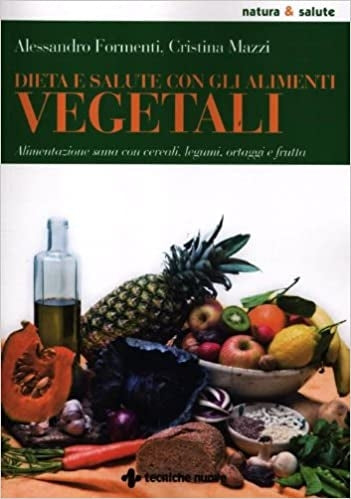Diet and health with vegetarian foods - Alessandro Formenti, Cristina Mazzi
Have a question?

Diet and health with vegetarian foods - Alessandro Formenti, Cristina Mazzi
Dettagli
Description
The species to which we belong, called Homo sapiens sapiens, appeared about 40,000 years ago, and since then it has maintained the anatomical-physiological characteristics that have distinguished it since its origin practically unchanged. In the meantime, however, man has gone from life in caves to the conquest of space, and his diet has undergone no less striking changes, far exceeding the adaptive possibilities of his digestive system.
This book describes in a clear and accessible way the basic rules of a diet that respects the needs of our organism , and presents the cereals, legumes, vegetables and fruits most commonly used in modern man's diet: these vegetables are among the most useful foods in our diet, precisely because they are the natural descendants of those edible parts of the plants that our ancestors chose as their foods many millions of years ago.
We could not find a food more suited to our nutritional needs, and by taking advantage of the nutritional and regulating power of these plants, even man in a mechanized society can validly contribute to the prevention and treatment of many diseases, appreciably raising the quality of own life.
For almost every species treated, an example of culinary application is also provided for a total of 100 simple, pleasant and beneficial recipes .
INDEX
Foreword by Stefano M. Candura
Introduction
Symbols, abbreviations and definitions
GENERAL PART
THE BIOLOGICAL EVOLUTION OF MAN AND HIS FOOD REQUIREMENTS
Chapter 1
Food and energy
Definition of food
Metabolism
The energy balance
Energy needs
Energy expenditure
The choice of foods
"Thin" foods
Bibliography
Chapter 2
Man in the biological world
Food niches
Carnivores
Herbivores
Omnivores
The man
Instinct
The evolution of Primates
Anatomy, physiology and eating habits
The new food strategy
Bibliography
Chapter 3
Foods
The nutritional principles
Carbohydrates
Lipids
Proteins
Alcohol
I LARN (recommended daily intake levels of energy and nutrients)
Bibliography
Chapter 4
Vitamins
Fat-soluble vitamins.
Water-soluble vitamins.
Vitaminoids
Bibliography
Chapter 5
Minerals and enzymes
The minerals
Enzymes
Bibliography
Chapter 6
Fibers and water
The fibres
The water
Bibliography
Chapter 7
Extranutritional properties of foods
Intercellular communication
Extranutritional aspects
The biocomplex
Nutrition and phytotherapy
The phytocomplex
The therapeutic profile
Botanical families
Condimentary plants
Notes on phytocomplex extraction techniques
Bibliography
Chapter 8
Nutrition and health
Eating errors and the origin of pathologies
Nutrition and diseases
Conclusions
Food balance
Cooking food
Balanced diet
The diet sheet
Recommended diet (for healthy person)
Menu for a typical day
Bibliography
SPECIAL PART
VEGETABLES, FRUITS, CEREALS AND LEGUMES
Chapter 9
Vegetables
Nutritional and pharmacological aspects
Liliaceae
Onion
Garlic
Shallot
Leek
Cipollaccto
Chives
Asparagus
Solanaceae
Potato
Tomato
Eggplant
Pepper
Red pepper
Composite or Asteraceae
Artichoke
Thistle
Dandelion
Jerusalem artichoke
Lettuce
Chicory
Scorzonera
Beak beard
Cruciferous
Cabbage
Savoy cabbage
Cabbage
Brussels sprouts
Cauliflower
Broccoli
Kohlrabi
Sea kale
Watercress
Ramolaccio, black horseradish and radish
Black horseradish
Radish
Navone
Turnip
Horseradish or horseradish
Rocket
White mustard
Umbelliferae
Parsley
Carrot
Fennel
Celery
Celeriac
Cucurbitaceae
Pumpkin
Zuchini
Cucumber
Chenopodiaceae
Spinach
Swiss chard or Swiss chard
Beet
Buon Enrico or wild spinach or culverin
Algae
Mushrooms
Truffles
Bibliography
Chapter 10
Fruit
Rosaceae
Apple
Pear
Strawberry
Cherry
Fishing
Apricot
Prune
Sloe
Quince
Medlar
Japanese medlar
Almond
Bitter almond
Raspberry
blue raspberry
Ericaceae
Blueberry
Cranberry
Ampelidaceae
Grape
Ebenaceae
Persimmons
Rutaceae
Lemon
Cedar
Orange
Bitter orange
Chinotto
Mandarin
Kumquats
Trifoliate orange
Grapefruit
Moraceae
FIG
Rhamnaceae
Jujube
Betulaceae
Hazelnut
Musaceae
Banana
Fagaceae
Chestnut
Oleaceae
Olive
Punicaceae
Pomegranate
Juglandaceae
Walnuts
Actinidiaceae
Kiwi
Palms
Date
Bromeliads
Pineapple
Bibliography
Chapter 11
Cereals
Background
The cereals one by one
Wheat
Corn
Barley
Rice
Rye
"Ergot"
Oats
Mile
Buckwheat
Quinoa
Amaranth
Kamut
Sorghum
Germination
Bibliography
Chapter 12
Legumes
Nutritional aspects
Extranutritional aspects
The legumes one by one
Beans
Peas
Lentils
Chickpeas
Grass peas
Soy
Peanuts
Fava beans
Lupins
Bibliography
Index of tables
Recipe index
Analytical index
Authors
Alessandro Formenti has a degree in Medicine and Surgery. Specialist in Food Science and Medical Hydrology, he was a professor of Phytotherapy at the University of Siena and of Food Science at the University of Pavia. For ten years he directed the Phytotherapy and Aromatherapy course at the International Center for Integrated Medicine in Bologna. He is one of the leading experts in Italy in Clinical Nutrition and Phytotherapy (about twenty thousand cases treated).
Cristina Mazzi has a diploma in Herbalist Medicine and studied Natural Nutrition and Eubiotics. He dedicates himself to the research and reworking of ancient dishes of traditional Italian cuisine. He lives and works in Valpolicella (VR).


